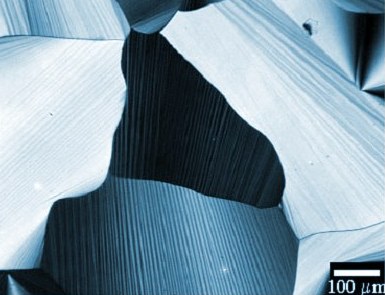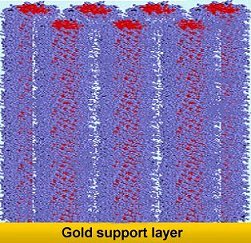US chemists are using liquid crystals as templates to help them synthesise novel plastics that conduct electricity. The technique could be used in the leap from laboratory to mass production of polymer-based components for displays, foil-batteries, and microelectronics devices.
Conducting polymers were first discovered in the 1970s by Alan Heeger, Alan MacDiarmid and Hideki Shirakawa, which won the three a share in the 2000 Nobel Prize for Chemistry. They and technologists around the world were quick to realise that polymers would have many advantages over the conventional semiconductor materials used for electronics components. For instance, they would be operable at lower, more efficient, voltages, they would be easily processable, into devices of almost any shape, and would ultimately be much cheaper to manufacture in bulk because of their ease of processibility.

Liquid crystals
Plastic electronics was to be the revolution of the turn of the century and once it was found that many conducting polymers also glowed the possibility of a flat-screen TV that could be rolled up in your pocket based on flexible conducting polymers was the classic image of chemistry in action. But, and there is always a but, the electrical conductivity of polymers has not yet reached the levels needed for the wide range of potential applications. This is due in part to structural disorder – a problem that prevails in plastics.
Now, Samuel Stupp and doctoral candidate James Hulvat at Northwestern University in Evanston (USA) have developed a new technique that forces conducting polymers into an ordered structure, which could overcome this obstacle.

Sam Stupp
There are many research teams around the world looking for ways to bring order to polymers. Stupp and Hulvat have concentrated their research on one particular group of conducting polymers, the polythiophenes, which the say are the most industrially important class of conducting polymers. They have used the self-organising power of liquid crystals to provide a template in which these polymers can be synthesised with an underlying order not possible in a free reaction.

Liquid crystal structures
Liquid crystals are fluid phases in which the individual particles have some degree of order as if they were in a solid crystal, which means they are structured. The US team produced a liquid crystalline gel composed of tiny, mutually parallel, hydrophobic (water repellent) cylindrical units, which are suspended in a hydrophilic (water loving) environment. They dissolve the building blocks for the polymer in this gel.

Liquid crystals showing how order generated
The building blocks, monomers, are themselves hydrophobic so they remain exclusively within the hydrophobic cylinders. The polymerisation reaction is kick-started with an electric current and the monomers start to link up to form long polymer chains. In a free solution, such polymer chains would kink and coil forming a conglomeration of random chains, reminiscent of a tangled bowl of spaghetti. However, the template cylinders keep the growing chains on the straight and narrow preventing them from becoming entangled. Once the gel is removed the polymeric material retains its order.
Our very simple new method could help in the production of conducting plastics with improved electronic properties, says Stupp. After the liquid crystals template is washed away, the polymers films remain stuck to the surface, an electrode, on which they are formed. Interestingly, these polymeric films essentially ‘copy’ the liquid crystal texture, revealing birefringent domains that match those of the liquid crystal medium, say the researchers. They suggest that the polymerization takes place within the confined nanoscale environment of the liquid crystals’ hydrophobic cores and produces polymer chains oriented parallel to the direction of the liquid crystal order.
The science and technology of low cost organic electronics could be advanced significantly by utilizing self-assembly processes to pattern and control the nanostructure of conducting polymers, adds Hulvat, this could simplify fabrication and improve efficiency of organic light-emitting diodes (OLEDs), organic field effect transistors and other devices.
Further reading
Angew. Chem. Int. Ed. 2003, 42(7), 778-781
http://www3.interscience.wiley.com/cgi-bin/abstract/103019628/START
DOI: 10.1002/anie.200390206
2000 Nobel Prize for Chemistry
http://nobelprize.org/nobel_prizes/chemistry/laureates/2000/
Samuel Stupp
http://www.matsci.northwestern.edu/faculty/sis.html
Suggested searches
Conducting polymers
Liquid crystals
Polymerisation